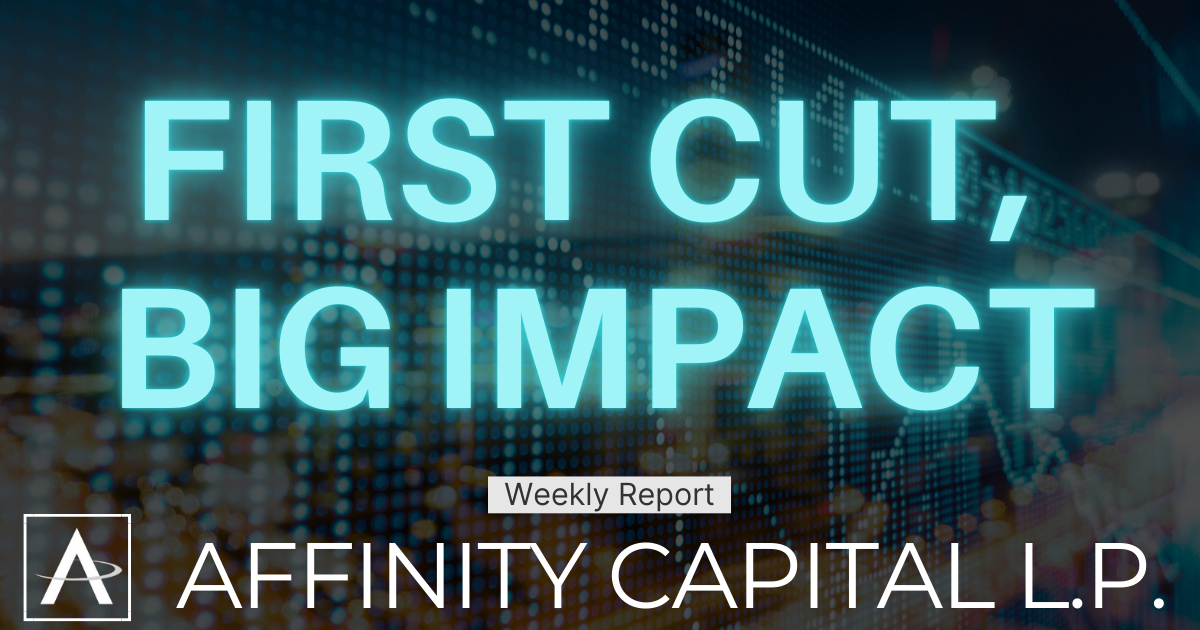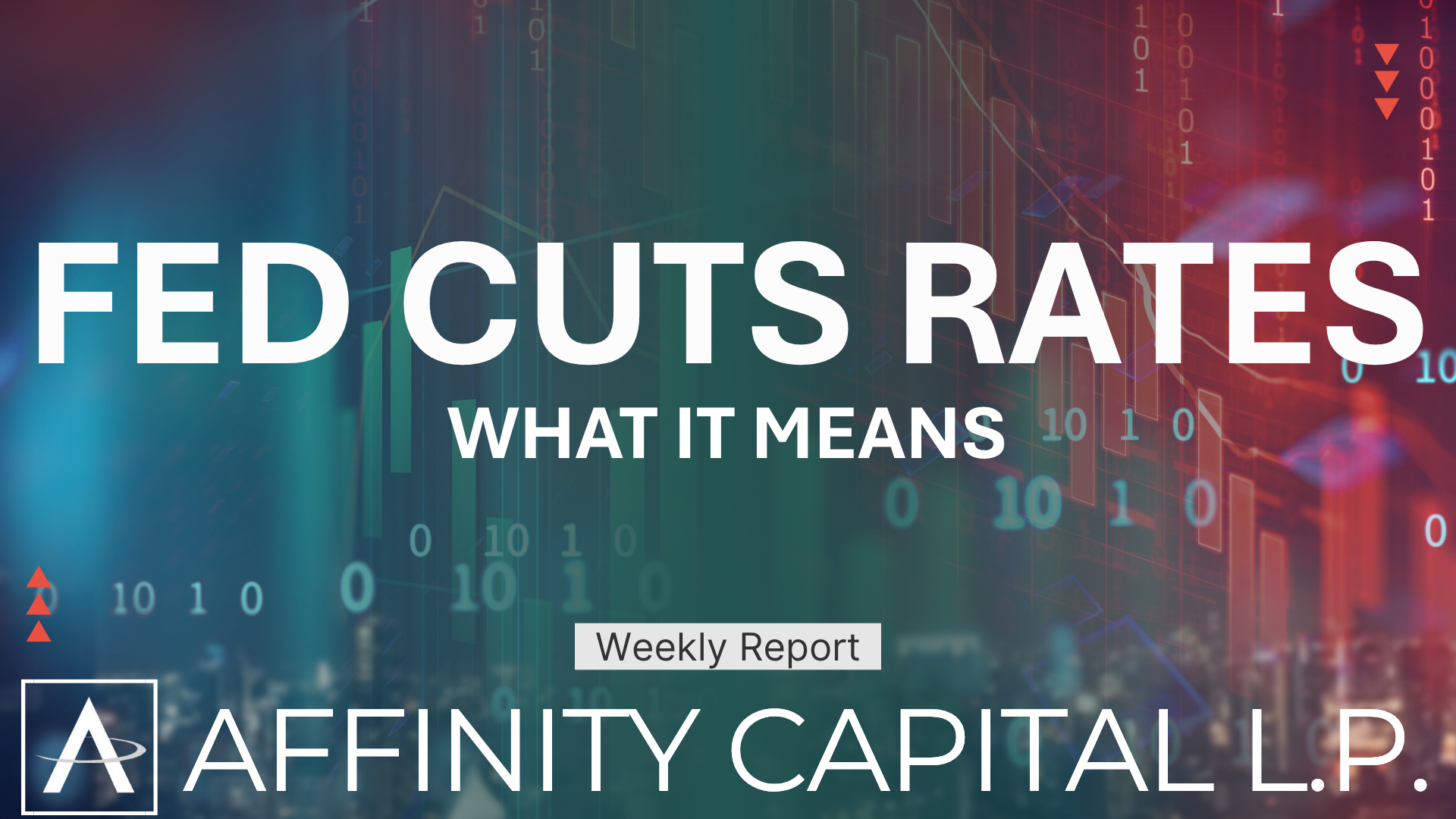Fed Makes First Cut—Markets React with Hope and Caution
September 17, 2025

The big news today: the Federal Reserve cut interest rates by 25 basis points, lowering the federal funds target range to 4.00%–4.25%. This is the first rate cut since 2023, and it marks what could be the beginning of a new easing cycle. Chair Powell acknowledged that the labor market is showing signs of strain—job growth has slowed, unemployment has edged higher—while inflation, though still above target, has been gradually moderating. One member of the committee even pushed for a larger 50-point cut, underscoring the growing concern about keeping the economy on stable footing.
Markets largely anticipated this move, and that helped set the tone for the week. The S&P 500 and Nasdaq hit new record highs earlier in the week, reflecting investor optimism that lower rates will support growth. Small-cap stocks also enjoyed a bounce, showing that confidence wasn’t limited to the mega-cap names. At the same time, Treasury yields fell toward 4% before inching back up, a sign that bond investors are weighing both the near-term relief of rate cuts and the longer-term risk that inflation remains sticky.
Economic data released this week helped frame the Fed’s decision. August inflation readings came in a touch hotter than expected, with headline CPI up 2.9% year over year and core inflation at 3.1%. Those numbers are still above the Fed’s target, but not high enough to derail its decision to pivot toward easing. Meanwhile, energy prices moved higher on global supply concerns, giving the energy sector a lift, while technology—especially companies tied to AI—continued to outperform.
Beyond the numbers, politics are adding a layer of uncertainty. Recent controversies around Fed appointments and legal challenges to sitting governors have raised questions about the central bank’s independence. Markets are watching closely to see whether these distractions influence policy direction. Globally, other central banks, including Canada’s, have also begun shifting to more accommodative stances, reinforcing the sense that the next phase of policy is easing across major economies.
So what does this mean looking ahead? Markets could see more upside in the short run, especially in interest-rate sensitive areas like housing and consumer spending. But investors should also prepare for continued volatility—each new jobs or inflation report has the potential to swing sentiment quickly. If inflation proves stickier than hoped, long-term Treasury yields could rise even as short-term rates fall, a dynamic that might pressure parts of the financial sector. In short, the path ahead is unlikely to be smooth, but the Fed has signaled it is prepared to act again, with two additional cuts projected before year-end.
Bottom line: The Fed has taken its first step toward easing, reflecting concerns about growth while balancing persistent inflation risks. Markets are encouraged, but optimism remains cautious as investors adjust to a more complex mix of risks and opportunities.
As always, we welcome your questions and are here to support you. At the heart of everything we do is our commitment to Wealth Management for Life—providing enduring guidance for you and your family’s financial success.

As we move into the final month of 2025, markets are adjusting to a new mix of encouraging economic trends and lingering uncertainty. November ended on a softer note, but December has opened with improved sentiment, clearer expectations around Federal Reserve policy, and a more confident tone in both equity and fixed income markets. Investors are watching these shifts closely, and the weeks ahead will help determine how the year ultimately finishes. At Affinity Capital, we continue to see an environment supported by quality leadership, steady earnings, and more attractive income opportunities. At the same time, late-cycle pressures and uneven economic data remind us that thoughtful risk management remains essential. A More Constructive Tone to Start December December began on firmer footing after several weeks of mixed performance. The most significant driver has been the market’s growing conviction that the Federal Reserve is getting closer to the start of a rate-cutting cycle. Current pricing suggests a meaningful chance of a cut in the near term, which has helped lift sentiment across equities and high-quality bonds. This optimism has also supported areas that tend to benefit from lower yield expectations, such as precious metals and rate-sensitive parts of the market. While not a guarantee of what comes next, the shift toward more accommodative policy expectations has created a more balanced backdrop than we saw earlier in the fall. Economic Data Remains Mixed Despite the improved tone, the incoming data continues to show pockets of weakness. Manufacturing activity has contracted for another month, hiring momentum has slowed, and consumer spending has moderated from its pace earlier in the year. The recent government shutdown delayed several economic releases, and the catch-up process has added some short-term noise to the data stream. What stands out is the contrast between a resilient corporate earnings picture and a softer macro environment. Many large companies continue to report healthy margins and steady demand, yet the broader economic indicators suggest that growth is losing some steam. This type of divergence is typical in late-cycle phases and often results in more frequent market swings. Volatility Has Picked Up After months of historically low volatility, markets have begun to experience more frequent fluctuations. Concerns around artificial intelligence valuations, regional banking stress, and geopolitical developments have all played a role. Volatility is not necessarily a sign of structural weakness, but it is a reminder that investors should expect a less predictable finish to the year. For diversified portfolios, these swings can create opportunities to rebalance, harvest gains, or add exposure to areas that have repriced more attractively. They also highlight the importance of high-quality holdings that can withstand periods of uncertainty. Opportunities Across Equities and Fixed Income Even with the mixed data backdrop, the overall investment environment remains constructive for long-term investors. High-quality U.S. companies with strong balance sheets and consistent earnings continue to provide stability at the core of portfolios. Select small-cap and mid-cap companies have also begun to show signs of improvement as rate expectations shift. In fixed income, today’s yields offer significantly more value than they did for much of the past decade. Bonds once again contribute meaningful income, and the possibility of lower rates in 2026 creates potential for price appreciation in high-grade credit. This combination strengthens the case for balanced portfolios that include both equities and fixed income. Positioning Into Year-End Given the current landscape, we believe the market is moving toward a finish that is neither overly exuberant nor overly cautious. Several key themes are likely to guide performance over the coming weeks. Quality leadership continues to play an important role, especially in sectors tied to innovation, cloud infrastructure, and digital transformation Broad market exposure remains valuable in capturing the benefits of seasonal strength and earnings resilience Dividend-oriented and defensive holdings support stability in late-cycle environments High-quality bonds offer attractive income and diversification benefits Small-cap and mid-cap allocations may provide long-term upside as rate expectations shift Looking Ahead As the year comes to a close, investors are balancing two realities. On one side, there is growing optimism around potential rate cuts, resilient corporate earnings, and improving seasonal patterns. On the other side, there are signs of slowing economic momentum, higher volatility, and continued geopolitical uncertainty. The result is a market that rewards discipline, diversification, and a focus on long-term goals. At Affinity Capital, our approach remains steady. We continue to emphasize high-quality holdings, balanced allocations, and thoughtful adjustments based on data rather than emotion. The coming months will bring new information, but the principles that guide long-term success remain unchanged. We are here to help clients stay aligned with their plans and positioned with confidence as we move into a new year.

The Federal Reserve announced today that it is cutting interest rates by a quarter of a percentage point, bringing the federal funds target range down to 3.75% to 4.00% . While it may sound like just another number, this decision carries real implications for the economy and financial markets. Why the Fed Made This Move The Fed has two primary goals: keep inflation under control and support a healthy job market. Over the last year, much of the focus has been on the first goal. Inflation has been stubborn, running higher than the Fed’s 2% target. Now, however, concerns about the job market are moving to the forefront. Hiring has slowed, and the Fed has acknowledged that risks to employment are rising. With economic data disrupted by the government shutdown, the central bank is working with incomplete information. In that uncertainty, officials chose to act in what they call a “risk management” mode, providing a bit of cushion for the economy. What This Means for the Economy Borrowing and Spending Lower rates typically filter into lower borrowing costs for businesses and households. That can mean slightly cheaper loans, credit cards, and mortgages. We have already seen mortgage rates dip in anticipation of this move, and that could provide some relief for homebuyers. Business Investment When financing is less expensive, businesses are more likely to expand, invest, and hire. The Fed hopes this cut provides enough encouragement to keep the labor market steady. The reality, however, is that a single quarter-point cut may only have a modest impact unless overall demand in the economy improves. Inflation Still in the Picture The challenge is that inflation has not gone away. By easing policy while prices are still running above target, the Fed runs the risk of letting inflation flare up again. That balancing act—supporting jobs without reigniting inflation—will be the key tension in the months ahead. Housing and Consumers The housing sector is especially sensitive to changes in interest rates. Builders and buyers often respond quickly when financing costs move even a little lower. At the same time, for households carrying debt, lower rates can make it easier to manage payments or refinance. But if wages stagnate or unemployment rises, those benefits may be limited. Markets and Volatility Markets had largely anticipated this cut, so the bigger story is what happens next. Investors are already debating whether this will be the first of several cuts, or just a one-off adjustment. That uncertainty often creates volatility in both stocks and bonds. The Bigger Picture The Fed has made it clear that there is no preset course. Officials will continue to watch the data and adjust policy as needed. That means future moves could go in either direction depending on whether inflation proves sticky or the job market weakens further. What does this mean in practical terms? It means we are entering a period where the Fed may be more reactive than proactive. Each new employment report, inflation reading, or sign of economic strength or weakness will take on outsized importance. Our Perspective For clients, the most important takeaway is that the Fed is signaling greater concern about the labor market, even as inflation remains above target. In other words, the economy is at a delicate point. The rate cut should provide some near-term relief, but it is not a magic fix. We are watching several key areas closely: The pace of hiring and unemployment trends Inflation data to see if price pressures start to ease or flare back up Housing activity, which could pick up if mortgage rates continue to drift lower The Fed’s move today is best seen as a stabilizing step. It shows policymakers are willing to provide support if needed, but it also highlights just how uncertain the path forward is. Periods like this can create noise in the markets, but they also underscore the value of staying focused on long-term goals. Our role is to keep a steady eye on developments, evaluate the implications, and make thoughtful decisions on your behalf. As always, we will continue monitoring the Fed’s actions and the broader economy, and we will keep you updated as the situation evolves.


